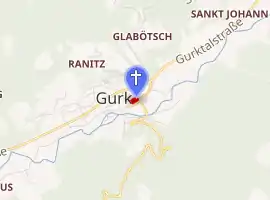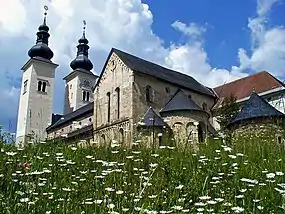Gurk Cathedral
Gurk Cathedral (German: Dom zu Gurk, officially Pfarr- und ehemalige Domkirche Mariae Himmelfahrt, Slovene: Bazilika v Krki) is a Romanesque pillar basilica in Gurk, in the Austrian state of Carinthia. The former cathedral and current co-cathedral of the Catholic Diocese of Gurk was built from 1140 to 1200, it is one of the most important Romanesque buildings in Austria.[1]
| Gurk Cathedral | |
|---|---|
 | |

| |
| Location | Gurk, Carinthia |
| Country | Austria |
| Denomination | Catholic |
| History | |
| Founded | c. 1140 |
| Founder(s) | Bishop Roman I of Gurk |
| Consecrated | 1200 |
| Architecture | |
| Functional status | Cathedral |
| Style | Romanesque |
| Administration | |
| Diocese | Diocese of Gurk |
| Clergy | |
| Bishop(s) | Alois Schwarz |

With its consecration in 1174, the grave of Saint Hemma of Gurk was relocated there from former Gurk Abbey, a Benedictine nunnery she had founded in 1043 and which was dissolved by Archbishop Gebhard of Salzburg in 1070/72, in order to fund the newly established Gurk diocese and the construction of the cathedral. The cathedral chapter established in 1123 moved to Klagenfurt in 1787.
Construction
The elongated building has a westwork with two towers, a gallery, a crypt, and three apses. The crypt, with its 100 columns, is the oldest part of the cathedral. In the middle of the rural Gurktal, the imposing 60 m (200 ft) tall twin steeple of the cathedral can be seen from a very great distance.
References
- UNESCO, Gurk Cathedral